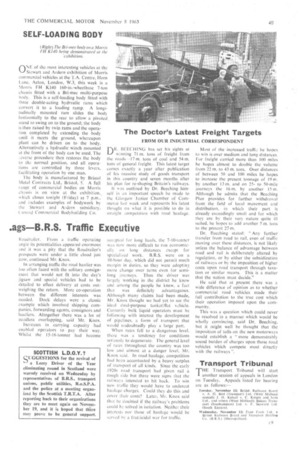Where Road Transpor .ags B.R.S, Traffic Executive
Page 52

Page 53

If you've noticed an error in this article please click here to report it so we can fix it.
EXAM1NATION of the effects of 1-4 automation elsewhere brought one reluctantly to the conclusion that road transport had not kept pace with modern trends, said Mr. Herbert Knox, divisional traffic officer, British Road Services, North Eastern. division, addressing the Institute of Transport Sheffield and District section on Monday. For instance, the vast changes that had taken place in the steel industry had not occurred by chance; in that sphere were the biggest spenders on research in the country.
B.R.S. had been associated with various developments but nothing truly revolutionary had been brought into being, said Mr. Knox. Off-the-floor palletization had been given the full treatment and looked well in the depot, but did not work out financially and so B.R.S. had been compelled sadly to discard it. Sneak thefts from lorries were a current trouble and work was now in progress on a tailboard that would return to the closed position when given a smart tap with the knee.
Mr. Knox said that lack of change in the haulage industry was perhaps due to the conservative outlook of the operators. Mr. Knox looked to the electrical industry to devise a motor that would drive a 16-ton rigid vehicle from Leeds to London without needing a 7-8 ton trailer to carry the batteries.
One of the most ingenious pieces of transport equipment to be introduced in recent years was the British Railways
RoacIrailer. From a traffic operating angle its potentialities appeared enormous and it was a pity that the Roadrailer's prospects were under a little cloud just now, continued Mr. Knox.
In arranging traffic the road haulier was too often faced with the solitary consignment that would not fit into the day's jigsaw and special vehicles had to be detailed to effect delivery at costs outweighing the return. More co-operation between the different interests was needed. Dock delays were a classic example which involved shipping companies, forwarding agents, consignors and hauliers. Altogether there was a lot of needless overlapping, said Mr. Knox.
Increases in carrying capacity had enabled operators to pay their way. Whilst the I 5-16-tonner had become
accepted for long hauls, the 7-10-tonner was now more difficult to run economically on long distances except for specialized work. B.R.S. were on a 10-hour day, which did not permit much margin in duties, so they were adopting more change over turns even for semilong journeys. Thus the driver was largely working in the district he knew and among the people he knew, a fact that was definitely advantageous. Although many claims had been made, Mr. Knox thought we had yet to see the ideal dual-purpose tanker/flat vehicle. Currently bulk liquid operators must be following with interest the development of pipelines, a form of transport that would undoubtedly play a large pare When rates fell to a dangerous level. there was a tendency for conditions seriously to degenerate. The general level of rates throughout the country was too low and almost at a danger level, Mr. Knox said, in road haulage, competition had been accentuated by a heavy -surplus of transport of all kinds. Since the early 1920s road transport had given rail a rough ride but there were signs that the railways intended to hit back. To win new traffic they would have to undercut haulage charges. Could they do this and cover their costs? Later, Mr. Knox said that he doubted if the railway's problems could be solved in isolation. Neither their interests nor those of haulage would be served he a fratricidal war for traffic.














































































































































































































































